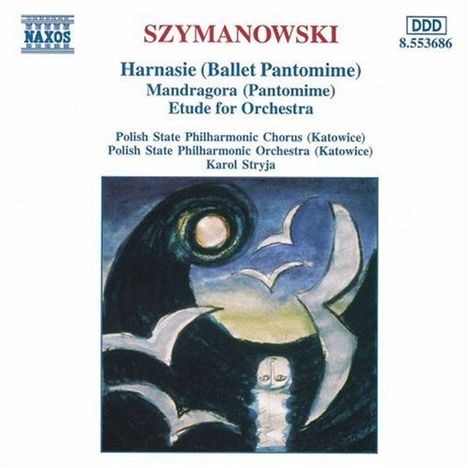Karol Szymanowski: Harnasie op.55 (Ballett-Pantomime) auf CD
Harnasie op.55 (Ballett-Pantomime)
Herkömmliche CD, die mit allen CD-Playern und Computerlaufwerken, aber auch mit den meisten SACD- oder Multiplayern abspielbar ist.
Lassen Sie sich über unseren eCourier benachrichtigen, falls das Produkt bestellt werden kann.
+Mandragora op. 43; Etude f. Orchester op. 4, 3
- Künstler:
- Katowice PO, Karol Stryja
- Label:
- Naxos
- Aufnahmejahr ca.:
- 1989
- UPC/EAN:
- 0730099468626
- Erscheinungstermin:
- 3.3.1997
Ähnliche Artikel
1921 besuchte Szymanowski Zakopane, einen Kurort in der Tatra, und studierte dort die reiche Volksmusik und den Volkstanz der Korallen, der Bewohner der Region, auf die ihn der Volksmusiksammler Adolf Chybinski aufmerksam gemacht hatte. Sein Interesse an der Region hielt an, und er mietete dort ein Haus bis 1936, als ihn die Umstände zwangen, es aufzugeben. Die Ballettmusik Harnasie, deren Titel eine Anspielung auf die legendären Banditen der Tatra ist, bedient sich der Volksmusik, die Szymanowski hörte, mit dem ganzen Reichtum seiner Phantasie und mit originellen Elementen, die ihre Inspiration aus der ursprünglichen Musik der Bergvölker beziehen, mit ihrer unregelmäßigen Akkzentuierung und ihrem vitalen Charakter.
Das Kurzballett Mandragora war für die Aufnahme in den dritten Akt von Molières Le bourgeois gentilhomme vorgesehen, dem Vorwand für die Ariadne auf Naxos von Richard Strauss. Das Stück, eine Pantomime in drei Szenen, wurde für das Polnische Theater in Warschau entworfen und dort im Juni 1920 aufgeführt. Es hat die Form eines commedia dell'arte intermezzo und enthält starke Elemente der musikalischen Parodie, jedoch nicht ohne den offensichtlichen Einfluss Strawinskys, dessen Petruschka Szymanowski so beeindruckt hatte, als er das Ballett 1913 sah. Szymanowski hatte den Klavierauszug sofort gekauft, da er fand, dass das Werk mit seinem wesentlichen slawischen Charakter sehr gut mit seinen damaligen musikalischen Neigungen übereinstimmte.
Die Etüde in b-Moll, ursprünglich für Klavier, bedarf keines Kommentars. Sie erfreute sich stets großer Beliebtheit, ihre Verbundenheit mit Chopin war offensichtlich und ihr melodischer Reiz unmittelbar, wie Paderewski feststellte. Szymanowski bedauerte die Popularität des Stücks und bemerkte gegenüber Fitelberg, der die vorliegende Fassung orchestrierte, dass es für einen Komponisten Pech sei, seine neunte Sinfonie so früh im Leben komponiert zu haben.
Product Information
In 1921 Szymanowski visited Zakopane, a health resort in the Tatra mountains, and there studied the rich folk-music and folk-dance of the Corals, the inhabitants of the region, to which his attention had been drawn by the folk- music collector Adolf Chybinski. His interest in the region continued and he rented a house there until 1936, when circumstances forced him to relinquish it. The ballet score Harnasie, its title an allusion to the legendary bandits of the Tatra mountains, makes full use of the folk-music that Szymanowski heard, presented with all the richness of his imagination and including original elements deriving their inspiration from the primitive music of the mountain people, with its irregular accentuation and vigorous character.
The short ballet Mandragora was designed for inclusion in the third act of Moliere's Le bourgeois gentilhomme, the pretext for the Ariadne auf Naxos of Richard Strauss. A pantomime in three scenes designed for the Polish Theatre in Warsaw, the piece was staged there in June 1920. It is in the form of a commedia dell'arte intermezzo and contains strong elements of musical parody, while not without the overt influence of Stravinsky, whose Petrushka had so impressed Szymanowski when he saw the ballet in 1913. Szymanowski had immediately bought the piano score, since he found the work, with its essential Slav character, coincided very much with his own musical inclinations at the time.
The Etude in B flat minor, originally for piano, needs no comment. It has always enjoyed wide popularity, its debt to Chopin apparent and its melodic appeal immediate, as Paderewski found. Szymanowski was to regret the popularity of the piece, remarking to Fitelberg, who orchestrated the present version, that it was bad luck for a composer to have composed his ninth symphony so early in life.
Disk 1 von 1 (CD)
-
1 Harnasie, Op. 55
-
2 Mandragora, Op. 43: Scene 1 - Scene 2
-
3 Mandragora, Op. 43: Scene 3
-
4 4 Studies, Op. 4: No. 3. Andante in modo d'una canzona (arr. G. Fitelberg): Etude for Orchestra in B flat minor, Op. 4,
Mehr von Karol Szymanowski
-
Karol SzymanowskiStabat Mater op.53CDVorheriger Preis EUR 19,99, reduziert um 0%Aktueller Preis: EUR 3,99
-
Karol SzymanowskiSämtliche MazurkenCDAktueller Preis: EUR 19,99
-
Karol SzymanowskiSymphonie Nr.2CDVorheriger Preis EUR 19,99, reduziert um 0%Aktueller Preis: EUR 9,99
-
Cesar FranckSonate für Violine & Klavier A-DurCDAktueller Preis: EUR 19,99









